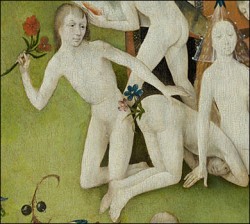
Riedl 2011
“The Garden of Earthly Delights: A diachronic interpretation of Hieronymus Bosch’s masterpiece” (Matthias Riedl) 2011
[published online in Academia.edu, December 2011, 26 pages. URL: academia.edu/3858747/The_Garden_of_Earthly_Delights_A_diachronic_interpretation_of_Hieronymus_Bosch’s_masterpiece_video_lecture_manuscript_and_slide_show_Budapest_2011(consulted 22 January 2021)]
This is the manuscript of a lecture delivered by Matthias Riedl at the Central European University, Budapest on 8 December 2011. By ‘diachronic interpretation’ Riedl means that an interpretation of Bosch should not only be based on contemporary sources but also on earlier basic texts of the Christian tradition, in particular on De civitate Dei by St Augustine. In Riedl’s opinion, Bosch’s Garden of Earthly Delights (Madrid), Haywain (Madrid), and Last Judgement (Vienna) agree with the overall structure of De civitate Dei, each of them dealing with a different stage of human history: beginning, progress, and end.
The centre panel of the Garden triptych shows the prelapsarian Eden, in other words mankind in the Garden of Eden before the Fall. St Augustine speculated about the question of what human existence would have looked like if Adam had not sinned, writing that sexuality would have been controlled by man’s will. In the Garden triptych Bosch made an original theological argument by deviating from St Augustine’s point of view. According to Bosch, man would not have been able to deal with sexuality in a rational way and his fall would have been inevitable. That is why the Eden in the left interior panel is already deeply ambiguous and why the centre panel shows some explicit scenes of sexual lust alongside innocent love scenes. Riedl considers this ‘the tragedy of human existence’: in Bosch’s representation of human sinfulness there is a sense of inevitability. The sexual desires which were necessary to fulfill the divine command of ‘be fruitful and multiply’ could at any time degenerate into lust and unrestrained passion. If Adam had not sinned, someone else would have, sooner or later.
About the presence of black men and women in the centre panel: not a word. About the pivotal scene with two men and one woman in the lower right corner of the centre panel: not a word. A few years ago, I read the complete De civitate Dei, and I can assure the reader there is very little or nothing there that can directly be related to Bosch. The statement that three Bosch triptychs echo the structure of St Augustine’s book is arbitrary. The author does seem to have a point when he notices echoes of Eden in the centre panel, but that Bosch wanted to show prelapsarian man’s inability to avoid sin does not sound very convincing. If the people shown in the centre panel are indeed prelapsarian, where then do the black men and women come from?
[explicit 22nd January 2021]